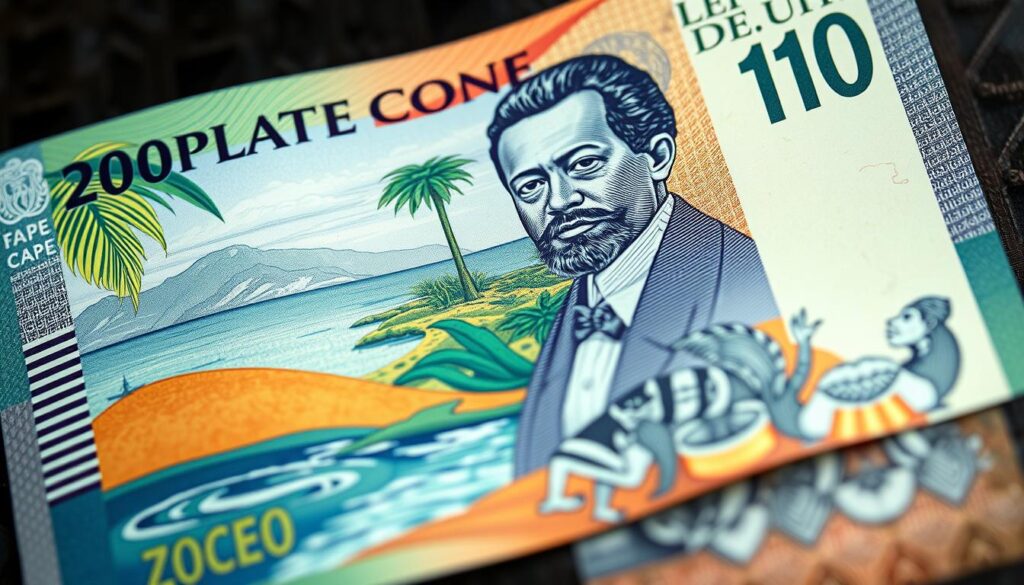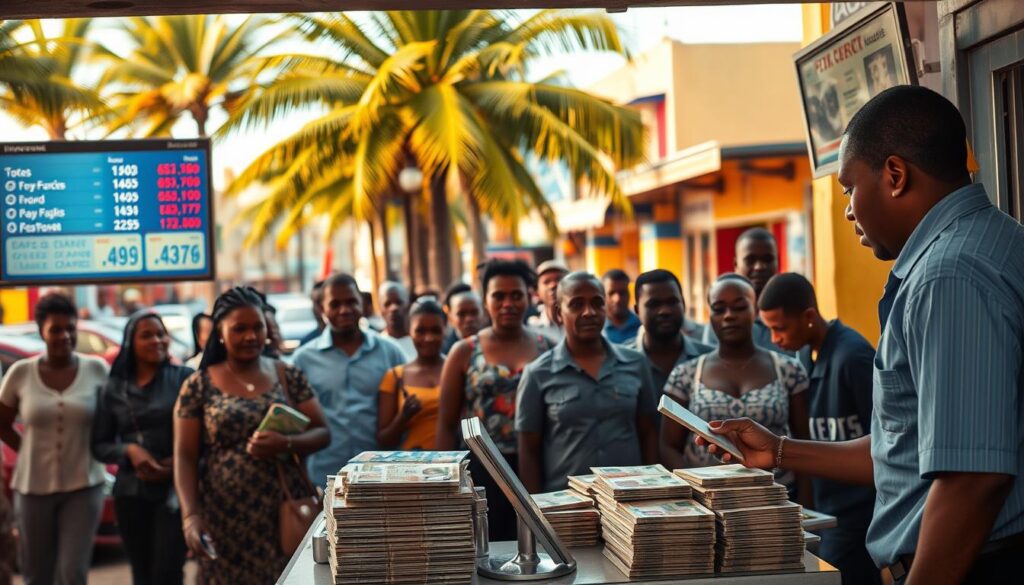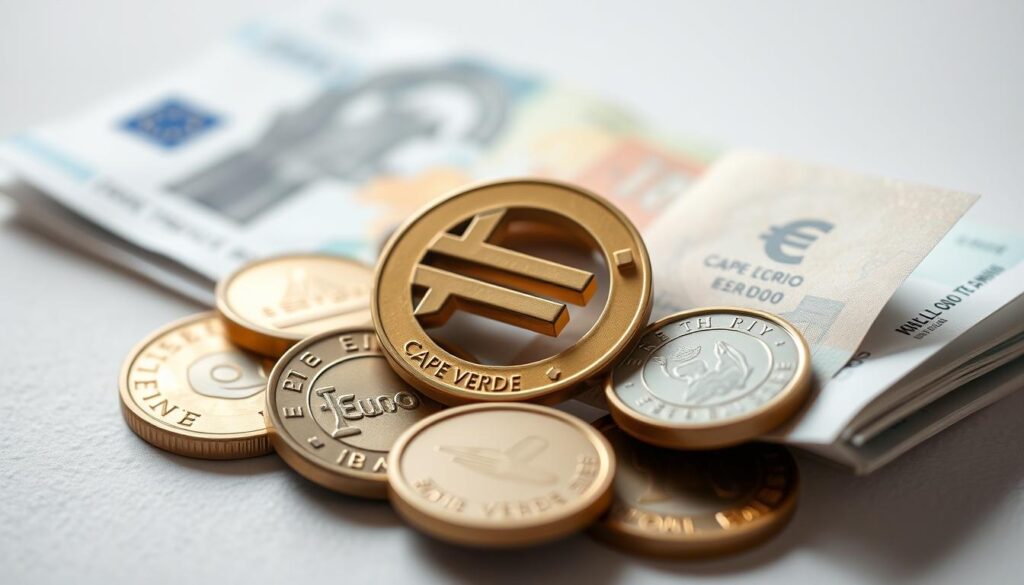
The Cape Verdean Escudo (CVE) is the official currency of Cape Verde. This island nation is located off the coast of West Africa. It has over 700,000 people and a growing economy. This attracts tourists and investors.
For travelers or investors, knowing the Cape Verdean Escudo is key. The CVE is tied to the Euro. This means exchange rates stay stable, making transactions easier.
The CVE is used all over the islands. It’s important to learn about the local currency. This way, you can enjoy your visit or investment more.
Key Takeaways
- The Cape Verdean Escudo is the official currency of Cape Verde.
- The CVE is pegged to the Euro, ensuring a stable exchange rate.
- Understanding the local currency is crucial for travelers and investors.
- The CVE is widely accepted across the islands.
- Exchange rates are relatively stable, simplifying transactions.
The Cape Verdean Escudo: An Overview
Knowing about the Cape Verdean Escudo is key for anyone visiting or working in Cape Verde. The Escudo is central to the country’s economy. It’s used in everyday transactions across the islands.
Currency Code and Symbol
The currency code for the Cape Verdean Escudo is CVE. It’s often shown as “$” or “Esc”, but “$” is more common. Yet, CVE is clearer since “$” is used by other currencies too.
The “$” symbol comes from Cape Verde’s past ties with other currencies. The CVE is not tied to the US dollar but to the Euro. This shows Cape Verde’s economic connections, especially with Europe.
Denominations of Coins and Banknotes
The Escudo comes in different coin and banknote sizes. Coins range from 1 to 100 Escudos. Banknotes are available from 200 to 5000 Escudos.
| Denomination Type | Available Denominations |
|---|---|
| Coins | 1, 5, 10, 20, 50, 100 Escudos |
| Banknotes | 200, 500, 1000, 2000, 5000 Escudos |
Visual Appearance and Security Features
Cape Verdean Escudo banknotes show off local and cultural themes. They also have advanced security to stop fake money. The designs celebrate Cape Verde’s history and culture.
These banknotes have watermarks, holograms, and detailed designs to prevent copying. They’re made of durable paper, lasting longer in use.
“The design and security features of the Cape Verdean Escudo banknotes are a testament to the country’s commitment to preserving its cultural identity while embracing modern security measures.”
Historical Background of Cape Verde’s Currency
The history of Cape Verde’s money shows its complex past. As a former Portuguese colony, its money history is linked to Portugal’s economy.
Colonial Currency History
During the colonial era, Cape Verde used the Portuguese Escudo. This was part of a system that connected Cape Verde to Portugal’s economy.
Introduction of the Escudo
After gaining freedom in 1975, Cape Verde kept using the Escudo. Now, its central bank issues it. The Cape Verdean Escudo was introduced, keeping a fixed rate with the Portuguese Escudo until the Euro came.
Currency Reforms and Modernization
Recently, Cape Verde has worked to update its financial system. It has introduced more secure money features and improved banking. These changes aim to make financial dealings more efficient and secure.
The Cape Verdean Escudo is key to the nation’s identity, showing its economic freedom. Its history marks the country’s move from colonial rule to an independent nation with its own money policies.
What Currency Do You Use in Cape Verde: The Official Legal Tender
In Cape Verde, the official money is the Cape Verdean Escudo. This currency, known as CVE, is key to the country’s economy. It’s used everywhere in the archipelago.
Status as National Monetary Unit
The Cape Verdean Escudo is the country’s main money. It’s made and watched over by the Banco de Cabo Verde (BCV). The Escudo is split into 100 centavos, but centavos are not used anymore. It has been the official money since it was first introduced, taking over from the old currency used before.
Acceptance Throughout the Archipelago
The Cape Verdean Escudo is accepted on all islands. It’s used for buying things and paying for hotels. This makes it easy for tourists to get around without needing to change money often.
| Island | Currency Accepted | Common Uses |
|---|---|---|
| Santiago | Cape Verdean Escudo | Local markets, restaurants |
| Sal | Cape Verdean Escudo | Hotels, tourist services |
| São Vicente | Cape Verdean Escudo | Everyday purchases, cultural events |
The Cape Verdean Escudo’s Exchange Rate
Knowing the Cape Verdean Escudo’s (CVE) exchange rate is key to understanding the country’s economy. It’s vital for travelers, investors, and businesses in Cape Verde.
Current Exchange Rates Against Major Currencies
The CVE’s rate against big currencies like the Euro, US Dollar, and British Pound matters a lot. Right now, the CVE is tied to the Euro, which keeps things steady. You can find the latest rates on financial news sites or at currency exchange places.
Historical Exchange Rate Trends
The CVE has kept a steady rate over time, thanks to its link with the Euro. This stability comes from Cape Verde’s economic plans and its ties to Portugal and the European Union. Knowing these trends helps guess future changes.
Factors Affecting the CVE’s Value
Many things affect the CVE’s value, like economic signs, tourism, and money sent from abroad. Cape Verde’s big tourism industry and its sensitivity to world economic changes can sway the rate. Also, its fixed rate with the Euro helps keep things stable.
Knowing the exchange rate is essential for anyone handling Cape Verdean money. Whether for travel, investing, or business, staying updated on rates and what affects them is smart.
Cape Verde’s Banking System and Currency Management
Cape Verde has a strong banking system that keeps its economy stable. This system is key for managing the Cape Verdean Escudo (CVE). It makes sure financial transactions are safe and smooth.
Role of the Central Bank of Cape Verde
The Central Bank of Cape Verde is very important for the country’s money and banking. It watches over banks, keeps the economy stable, and handles foreign money. The bank also makes sure the Cape Verdean Escudo is used right in the economy.
Commercial Banking Infrastructure
Cape Verde has a good banking setup, with many banks on the islands. These banks offer services like personal and business banking, loans, and foreign exchange. A strong banking system helps the economy grow by making it easy for people and businesses to get financial help.
Financial Regulations and Monetary Policy
Cape Verde has rules to keep its financial system stable and honest. The Central Bank uses money policies to fight inflation, control money exchange, and keep the economy healthy. These rules and policies help keep investors confident and support the economy’s growth.
| Banking Service | Description | Availability |
|---|---|---|
| Personal Banking | Services for individuals, including savings accounts and loans. | Widely available across all islands. |
| Business Banking | Financial services tailored for businesses, including loans and cash management. | Available in major islands, with some services accessible online. |
| Foreign Exchange | Services for exchanging currencies, including the Cape Verdean Escudo. | Available at banks and some currency exchange offices. |
Currency Exchange Options for Travelers
Travelers visiting Cape Verde have many ways to exchange their money. This makes it easy to manage your finances while having fun. You can choose what works best for you.
Airport and Port Exchange Services
When you arrive, you can exchange money at the airport or port. These places offer a convenient service, but it might cost a bit more. It’s smart to have some local money, the Cape Verdean Escudo (CVE), ready for your first expenses.
Exchange rates at airports and ports might not be the best. So, it’s wise to exchange only what you need for the first few days. Look for better rates later.
Banks and Official Exchange Offices
Banks and official exchange offices give good exchange rates. They are safe and reliable. You can also withdraw CVE with your debit or credit card here.
| Location | Exchange Rate | Transaction Fees |
|---|---|---|
| Banks | Competitive | Minimal |
| Official Exchange Offices | Competitive | Minimal |
| Airport/Port | Less Competitive | Higher |
Hotels and Tourist Areas
Hotels and tourist spots often have currency exchange services. But, the rates might not be as good as at banks or official offices. It’s important to compare rates to avoid losing money.
Best Rates and Avoiding Scams
To get the best rates, compare them at different places. Knowing the current exchange rate and being careful of scams can save you money. Using trusted services and watching out for fees can also help avoid extra costs.

Using Credit Cards and ATMs in Cape Verde
Credit cards and ATMs are common in Cape Verde, making it easy for tourists to handle their money. You can find ATMs and places to use credit cards in many spots across the islands. This makes it simple to get cash and pay for things.
ATM Availability Across Different Islands
Most big towns and tourist spots have ATMs. Islands like Santiago and Sal have more ATMs. But, smaller islands might have fewer. It’s smart to carry some local money, the Cape Verdean Escudo (CVE), for when you first arrive, especially in less visited places.
Credit Card Acceptance and Foreign Transaction Fees
Credit cards like Visa and Mastercard are accepted in many places. But, some small shops or remote areas might not take them. It’s wise to have cash for these places. Also, watch out for foreign transaction fees when using cards or ATMs. These fees vary by bank, sometimes it’s a flat fee, other times a percentage of the transaction.
| Card Type | Acceptance | Typical Foreign Transaction Fees |
|---|---|---|
| Visa | Widely accepted | 1%-3% |
| Mastercard | Widely accepted | 1%-3% |
| American Express | Less commonly accepted | 2%-4% |
The Euro Connection: Cape Verde’s Currency Peg
Cape Verde’s money policy is special because it’s tied to the Euro. This is because of its past with Portugal. This fixed rate has big effects on the country’s economy.

The Fixed Exchange Rate Agreement with Portugal
The Cape Verdean Escudo (CVE) is tied to the Euro (EUR) at a fixed rate. This rate is 1 EUR = 110.265 CVE. This comes from Cape Verde’s old ties with Portugal, which used the Escudo before switching to the Euro in 1999.
This fixed rate makes financial dealings stable and easy to predict, especially with European countries.
Economic Benefits and Challenges of the Peg
The currency peg has many good points. It lowers the risk of exchange rate changes and boosts investor confidence. But, it also limits Cape Verde’s control over its money policy.
The country’s economy is closely linked to the Eurozone’s. This can affect Cape Verde’s stability.
The peg makes trade and investment easier with Europe. This helps Cape Verde grow economically. But, the country must manage its policies well to keep the peg stable and support long-term growth.
Traveling with Cape Verdean Currency: Practical Tips
When you travel to Cape Verde, knowing the local currency is key. The Cape Verdean Escudo is what you’ll use. It’s important to understand how to use it during your trip.
Recommended Cash Amounts for Different Trip Types
The cash you need can change based on your trip type. For a fancy vacation, you might need more for expensive activities and meals. On the other hand, a budget trip might need less. It’s smart to have some local money ready for when you arrive.
- Budget travelers: About 1,000 CVE per day for basic needs.
- Mid-range travelers: 2,500 CVE per day for a bit more comfort.
- Luxury travelers: 5,000 CVE or more per day for top-notch experiences.
Currency Import and Export Restrictions
Cape Verde has rules for bringing in and taking out its currency. There are limits on how much CVE you can move. Always check the latest rules before you go to avoid problems.
Tipping Customs and Payment Practices
Tipping in Cape Verde is less than in many places, but it’s still nice for good service. Knowing how people pay and use credit cards can make your trip better.
Some important things to remember:
- Tipping: 5-10% is standard in restaurants and bars.
- Credit cards: They’re widely accepted in tourist spots and big places.
- ATMs: You can find them on most islands, but having cash is always a good idea.
Future Outlook for the Cape Verdean Escudo
The Cape Verdean Escudo (CVE) is closely linked to the country’s economic plans and money policies. As the economy grows, the CVE’s stability and worth will be shaped by many factors.
Potential Currency Developments and Reforms
The CVE might see updates in how it manages money. Possible changes could include:
- Enhanced security features for banknotes and coins
- Digital currency initiatives
- Reforms in foreign exchange regulations
These updates could make financial dealings in Cape Verde more efficient and secure.
Economic Factors Influencing Future Stability
Several economic factors will be key in shaping the CVE’s future:
| Economic Factor | Impact on CVE |
|---|---|
| Inflation Rate | High inflation could make the CVE less valuable |
| Foreign Investment | More investment could strengthen the CVE |
| Tourism Growth | More tourists could increase demand for CVE |
Keeping an eye on these factors is vital for understanding the CVE’s future.
Conclusion
The Cape Verdean Escudo (CVE) is the official currency of Cape Verde. It plays a key role in the country’s economy. We’ve looked at its history, use, and importance for both locals and visitors.
The CVE is tied to the Euro, keeping exchange rates stable. This helps Cape Verde’s economy connect with Europe. You can find coins and banknotes in different values, all with special features to stop fake money.
Visitors can easily swap their money at airports, banks, and exchange offices. Credit cards and ATMs are also common, making it easy to get local cash.
In short, knowing about the Cape Verdean Escudo is crucial for a great trip to Cape Verde. Its stable rate and wide acceptance make it a reliable choice for tourists and business travelers. It supports Cape Verde’s growing economy well.
FAQ
What is the official currency used in Cape Verde?
The official currency in Cape Verde is the Cape Verdean Escudo (CVE).
Can I use Euros in Cape Verde?
While some places might take Euros, the Cape Verdean Escudo is best for buying things. It’s wise to exchange your money for CVE to get a good deal.
How do I exchange my currency for Cape Verdean Escudos?
You can exchange money at airports, ports, banks, and official exchange offices. ATMs also let you withdraw CVE.
Are credit cards widely accepted in Cape Verde?
Yes, many places, especially in tourist areas, accept credit cards. But, it’s smart to have some local currency for small purchases or at local shops.
What is the exchange rate between the Cape Verdean Escudo and the Euro?
The CVE is tied to the Euro at a fixed rate. This rate is set by the Central Bank of Cape Verde.
Can I withdraw Cape Verdean Escudos from an ATM using my debit/credit card?
Yes, you can withdraw CVE from ATMs across the islands with your debit or credit card. Just watch out for any foreign transaction fees.
Is it safe to use ATMs in Cape Verde?
ATMs in Cape Verde are generally safe, especially in secure spots like banks or malls. Still, it’s wise to be careful with your card and PIN.
What are the denominations of Cape Verdean Escudo banknotes and coins?
The Cape Verdean Escudo comes in different banknote and coin sizes. You can find out more about these in the section on the currency’s physical features.
Are there any restrictions on importing or exporting Cape Verdean Escudos?
Yes, there are rules about bringing in or taking out local currency. It’s best to check with the authorities or a travel advisor for the latest info.
How does the currency peg to the Euro affect Cape Verde’s economy?
The peg to the Euro has both good and bad sides for the economy. It brings stability but also means Cape Verde’s money policy is tied to the European Central Bank’s decisions.

Adam G
This post was created by Adam G, a seasoned financial writer with a passion for explaining currency exchange and market movements
